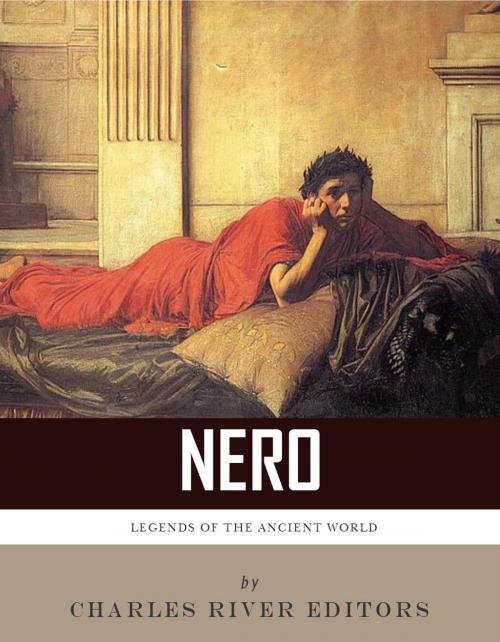Legends of the Ancient World: The Life and Legacy of Nero
Nonfiction, History, Ancient History, Rome, Biography & Memoir, Historical| Author: | Charles River Editors | ISBN: | 9781475318326 |
| Publisher: | Charles River Editors | Publication: | October 11, 2012 |
| Imprint: | Language: | English |
| Author: | Charles River Editors |
| ISBN: | 9781475318326 |
| Publisher: | Charles River Editors |
| Publication: | October 11, 2012 |
| Imprint: | |
| Language: | English |
*Describes ancient accounts of Nero's reign, including the murder of his mother, the Great Fire of Rome, and his suicide.*Includes pictures of famous art depicting Nero and important people in his life.*Includes a Bibliography for further reading.*Includes a Table of Contents. "What an artist dies with me! Attributed to Nero just before his suicideA lot of ink has been spilled covering the lives of historys most influential figures, but how much of the forest is lost for the trees? In Charles River Editors Legends of the Ancient World series, readers can get caught up to speed on the lives of antiquitys most important men and women in the time it takes to finish a commute, while learning interesting facts long forgotten or never known. Throughout the annals of history, there have been few figures as reviled as Lucius Domitius Ahenobarbus, better known as Nero Claudius Caesar Drusus Germanicus, or more simply, Nero. Even today, he remains one of the Roman Empires most famous or notorious figures, a villain whose impact on popular culture is so vast that his name crops up consistently to this day in literature, film, TV and mediums as unlikely as video games and anime.Nero ranks among the very worst of the Caesars, alongside the likes of mad Caligula, slothful Commodus, and paranoid Domitian, a figure so hated that, in many ancient Christian traditions, he is literally, without hyperbole, considered the Antichrist; according to a notable Biblical scholar, the coming of the Beast and the number 666 in the Book of Revelation are references to Nero. He was the man who, famously, fiddled while Rome burned, an inveterate lecher, a murderous tyrant who showed little compunction in murdering his mother and who liked to use Christian martyrs as a source of illumination at night by burning them alive. His economic policies, according to many historians, virtually bankrupted Rome. The best known accounts of Nero come from biographers like Tacitus, Cassius Dio, Suetionius and Josephus, but there are also indications that, to some extent, reports of Neros cruelty were exaggerated. Nero was popular with the common people and much of the army, and during his reign the Empire enjoyed a period of remarkable peace and stability. Many historians, including some of his ancient biographers such as Josephus suggest that there existed a strong bias against Nero. Part of this is because his successors wished to discredit him, and justify the insurrections which eventually drove him, hounded from the throne, to a lonely suicide. Much of the bias against Nero can also be attributed to the fact that he was a renowned persecutor of Christians, and since many of the historians who wrote about Nero in the years after his death were Christians themselves, it made sense for them to have a jaundiced view of their erstwhile nemesis. Because of this, some historians have suggested that Neros demeanour and reputation might not be as black as the original sources might be inclined to suggest. Legends of the Ancient World: The Life and Legacy of Nero looks at the life of one of Romes most notorious emperors and attempts to separate fact from fiction to analyze his reign and legacy. Along with pictures of important people, places, and events, you will learn about Nero like you never have before, in no time at all.
*Describes ancient accounts of Nero's reign, including the murder of his mother, the Great Fire of Rome, and his suicide.*Includes pictures of famous art depicting Nero and important people in his life.*Includes a Bibliography for further reading.*Includes a Table of Contents. "What an artist dies with me! Attributed to Nero just before his suicideA lot of ink has been spilled covering the lives of historys most influential figures, but how much of the forest is lost for the trees? In Charles River Editors Legends of the Ancient World series, readers can get caught up to speed on the lives of antiquitys most important men and women in the time it takes to finish a commute, while learning interesting facts long forgotten or never known. Throughout the annals of history, there have been few figures as reviled as Lucius Domitius Ahenobarbus, better known as Nero Claudius Caesar Drusus Germanicus, or more simply, Nero. Even today, he remains one of the Roman Empires most famous or notorious figures, a villain whose impact on popular culture is so vast that his name crops up consistently to this day in literature, film, TV and mediums as unlikely as video games and anime.Nero ranks among the very worst of the Caesars, alongside the likes of mad Caligula, slothful Commodus, and paranoid Domitian, a figure so hated that, in many ancient Christian traditions, he is literally, without hyperbole, considered the Antichrist; according to a notable Biblical scholar, the coming of the Beast and the number 666 in the Book of Revelation are references to Nero. He was the man who, famously, fiddled while Rome burned, an inveterate lecher, a murderous tyrant who showed little compunction in murdering his mother and who liked to use Christian martyrs as a source of illumination at night by burning them alive. His economic policies, according to many historians, virtually bankrupted Rome. The best known accounts of Nero come from biographers like Tacitus, Cassius Dio, Suetionius and Josephus, but there are also indications that, to some extent, reports of Neros cruelty were exaggerated. Nero was popular with the common people and much of the army, and during his reign the Empire enjoyed a period of remarkable peace and stability. Many historians, including some of his ancient biographers such as Josephus suggest that there existed a strong bias against Nero. Part of this is because his successors wished to discredit him, and justify the insurrections which eventually drove him, hounded from the throne, to a lonely suicide. Much of the bias against Nero can also be attributed to the fact that he was a renowned persecutor of Christians, and since many of the historians who wrote about Nero in the years after his death were Christians themselves, it made sense for them to have a jaundiced view of their erstwhile nemesis. Because of this, some historians have suggested that Neros demeanour and reputation might not be as black as the original sources might be inclined to suggest. Legends of the Ancient World: The Life and Legacy of Nero looks at the life of one of Romes most notorious emperors and attempts to separate fact from fiction to analyze his reign and legacy. Along with pictures of important people, places, and events, you will learn about Nero like you never have before, in no time at all.















